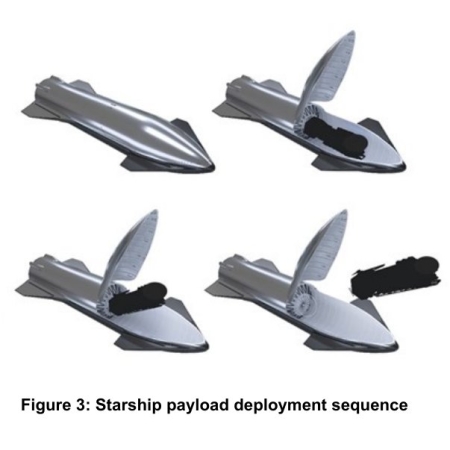Boeing’s fall from grace at NASA
Eric Berger at Ars Technica yesterday uncovered a NASA report that outlined its selection process for awarding a contract for providing cargo to the agency’s proposed Lunar Gateway space station — eventually won by SpaceX — that gave Boeing’s proposal a terrible ranking.
Of the four contenders, [Boeing] had the lowest overall technical and mission suitability scores. In addition, Boeing’s proposal was characterized as “inaccurate” and possessing no “significant strengths.” Boeing also was cited with a “significant weakness” in its proposal for pushing back on providing its software source code.
Due to its high price and ill-suited proposal for the lunar cargo contract, NASA didn’t even consider the proposal among the final bidders. In his assessment late last year, NASA’s acting chief of human spaceflight, Ken Bowersox, wrote, “Since Boeing’s proposal was the highest priced and the lowest rated under the Mission Suitability factor, while additionally providing a conditional fixed price, I have decided to eliminate Boeing from further award consideration.” [emphasis mine]
The highlighted words could possibly be a death sentence for Boeing. The company has numerous other serious problems, including its commercial 737-Max airplane, its KC-46 Pegasus tanker for the Air Force, and of course its SLS rocket for NASA. For NASA to say that it will no longer consider Boeing in future contract bidding, especially since NASA has been one of Boeing’s biggest customers for decades, cannot be good for the company’s already badly suffering bottom line.
Berger also notes how much NASA’s attitude toward Boeing has changed since the agency removed Bill Gerstenmaier as head of its manned space operations. Gerstenmaier had apparently given Boeing the highest marks routinely, and appeared to have lost his ability to look at the company objectively. Moreover, his (and NASA’s) kid-glove treatment of Boeing for decades probably contributed to that company’s sloppy bid on the Lunar Gateway cargo contract. They were likely not used to tough questioning, and didn’t put the proper effort into writing their bid.
For the taxpayer and the American space effort, however, this report is wonderful news. It appears that NASA is breaking its tight and blind partnership with the big space contractors that has for decades handicapped the nation’s ability to get things built in space. These contractors have not been able to deliver, but because of their powerful allies on Congress, NASA has for years kowtowed to them in contract awards.
Now however it appears NASA’s management has become quite willing to reject these powerful companies, despite Congressional backing, in order to get the best deal and the best product, for the nation.
Eric Berger at Ars Technica yesterday uncovered a NASA report that outlined its selection process for awarding a contract for providing cargo to the agency’s proposed Lunar Gateway space station — eventually won by SpaceX — that gave Boeing’s proposal a terrible ranking.
Of the four contenders, [Boeing] had the lowest overall technical and mission suitability scores. In addition, Boeing’s proposal was characterized as “inaccurate” and possessing no “significant strengths.” Boeing also was cited with a “significant weakness” in its proposal for pushing back on providing its software source code.
Due to its high price and ill-suited proposal for the lunar cargo contract, NASA didn’t even consider the proposal among the final bidders. In his assessment late last year, NASA’s acting chief of human spaceflight, Ken Bowersox, wrote, “Since Boeing’s proposal was the highest priced and the lowest rated under the Mission Suitability factor, while additionally providing a conditional fixed price, I have decided to eliminate Boeing from further award consideration.” [emphasis mine]
The highlighted words could possibly be a death sentence for Boeing. The company has numerous other serious problems, including its commercial 737-Max airplane, its KC-46 Pegasus tanker for the Air Force, and of course its SLS rocket for NASA. For NASA to say that it will no longer consider Boeing in future contract bidding, especially since NASA has been one of Boeing’s biggest customers for decades, cannot be good for the company’s already badly suffering bottom line.
Berger also notes how much NASA’s attitude toward Boeing has changed since the agency removed Bill Gerstenmaier as head of its manned space operations. Gerstenmaier had apparently given Boeing the highest marks routinely, and appeared to have lost his ability to look at the company objectively. Moreover, his (and NASA’s) kid-glove treatment of Boeing for decades probably contributed to that company’s sloppy bid on the Lunar Gateway cargo contract. They were likely not used to tough questioning, and didn’t put the proper effort into writing their bid.
For the taxpayer and the American space effort, however, this report is wonderful news. It appears that NASA is breaking its tight and blind partnership with the big space contractors that has for decades handicapped the nation’s ability to get things built in space. These contractors have not been able to deliver, but because of their powerful allies on Congress, NASA has for years kowtowed to them in contract awards.
Now however it appears NASA’s management has become quite willing to reject these powerful companies, despite Congressional backing, in order to get the best deal and the best product, for the nation.

